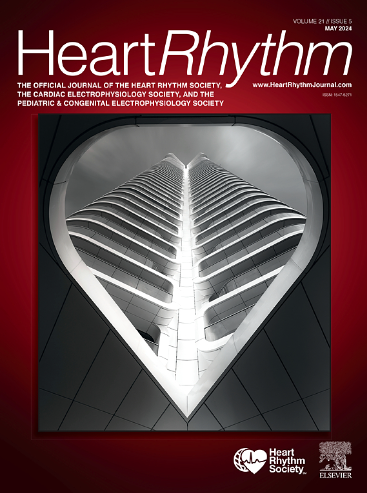The vestigial fold in humans: Characterization of a potential novel target for selective cardiac sympathetic denervation
IF 5.7
2区 医学
Q1 CARDIAC & CARDIOVASCULAR SYSTEMS
引用次数: 0
Abstract
Background
The vestigial fold is an epicardial structure related to the posterior hilum of the heart, containing the remnant of the left superior vena cava. It is the superior continuation of the ligament/vein of Marshall. Although neural structures along the human ligament/vein of Marshall have been characterized, those within the human vestigial fold remain unexplored.
Objective
This study aimed to characterize the neural structures within the human vestigial fold.
Methods
Twelve human vestigial fold samples (67% men, 50.0 ± 12.7 years) were analyzed. Nerve fascicles ≥ 50 μm in diameter were counted and characterized by immunohistochemistry staining. Percentage area of sympathetic, parasympathetic, and sensory nerve fibers (axons) within individual nerve fascicles was measured.
Results
A total of 87 nerve fascicles were analyzed. The size of the vestigial fold averaged 12.7 ± 5.1 mm in length and 3.6 ± 1.7 mm in width. Each vestigial fold contained 7.3 ± 4.2 nerve fascicles (102.0 ± 51.8 μm in diameter). The minimum distance from the epicardium to nerve fascicles was 487.1 ± 440.2 μm. Immunohistochemistry showed sympathetic predominance (Percentage area within each fascicle; sympathetic 16.9 ± 12.7%, parasympathetic 1.6 ± 1.0%, and sensory 1.2 ± 1.0%, P < .001). Representative whole-mount staining of the tissue-cleared sample also confirmed 3-dimensional distribution of the predominant sympathetic nerve fascicles within the vestigial fold.
Conclusion
The vestigial fold predominantly contains sympathetic nerve fascicles. This epicardial structure is a potential novel target for selective human cardiac sympathetic denervation, especially in cases with uncontrollable ventricular arrhythmia arising from the inferior left ventricle.

人类的退化褶皱:选择性心脏交感神经去神经的潜在新靶点的表征。
背景:残留褶皱是一种与心脏后门部有关的心外膜结构,包含左侧上腔静脉的残余。这是马歇尔韧带/静脉的上延。虽然沿着人类韧带/马绍尔静脉的神经结构已被表征,但那些在人类退化褶皱内的神经结构仍未被探索。目的:研究人类退化褶内的神经结构。方法:对12例人类退化褶皱标本(男性67%,年龄50.0±12.7岁)进行分析。对直径≥50 μm的神经束进行计数和免疫组化染色。测量单个神经束内交感、副交感和感觉神经纤维(轴突)面积的百分比。结果:共分析了87个神经束。残留褶皱的平均长度为12.7±5.1 mm,宽度为3.6±1.7 mm。每个退化褶皱包含7.3±4.2个神经束(直径102.0±51.8 μm)。心外膜到神经束的最小距离为487.1±440.2 μm。免疫组化示交感神经优势(各神经束面积百分比;结论:退化褶皱以交感神经束为主。这种心外膜结构是选择性人类心脏交感神经断神经的潜在新靶点,特别是在由下左心室引起的不可控室性心律失常的病例中。
本文章由计算机程序翻译,如有差异,请以英文原文为准。
求助全文
约1分钟内获得全文
求助全文
来源期刊

Heart rhythm
医学-心血管系统
CiteScore
10.50
自引率
5.50%
发文量
1465
审稿时长
24 days
期刊介绍:
HeartRhythm, the official Journal of the Heart Rhythm Society and the Cardiac Electrophysiology Society, is a unique journal for fundamental discovery and clinical applicability.
HeartRhythm integrates the entire cardiac electrophysiology (EP) community from basic and clinical academic researchers, private practitioners, engineers, allied professionals, industry, and trainees, all of whom are vital and interdependent members of our EP community.
The Heart Rhythm Society is the international leader in science, education, and advocacy for cardiac arrhythmia professionals and patients, and the primary information resource on heart rhythm disorders. Its mission is to improve the care of patients by promoting research, education, and optimal health care policies and standards.
 求助内容:
求助内容: 应助结果提醒方式:
应助结果提醒方式:


